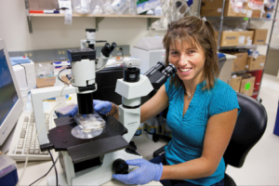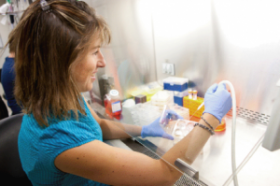Giving the brain a hand
PROFILE: Scientist Kristen Brennand uses stem cells to understand brain disorders
By Susan Gaidos

To figure out how your brain cells behave, scientist Kristen Brennand would first look at the skin on your hand. As a postdoctoral fellow in the lab of Fred Gage at the Salk Institute for Biological Studies in San Diego, Brennand transforms skin cells into brain cells to study how the brain behaves in health and disease. It sounds like magic, but it’s not: Before brain cells become full-grown neurons, they start out as immature stem cells. Stem cells have the ability to become any type of cell. In her lab, Brennand takes skin cells back in time, transforming them into stem cells. She then coaxes them to become brain cells. She’s using this approach to compare healthy brain cells to those in people with schizophrenia, a common mental illness, and to those of people with autism.
Here, Brennand, who earned her Ph.D. from Harvard University, describes her research to science writer Susan Gaidos.
Susan Gaidos: How can you study someone’s brain by looking at his or her skin cells?
Kristen Brennand: About four years ago, some scientists in Japan discovered that you can turn skin cells into stem cells. In fact, the stem cells that you get are almost identical to embryonic stem cells, which means that they can make every cell type found in the adult body. For our experiment, we first turn the skin cells into stem cells. Then we can make brain cells from the stem cells. So we have to go: skin cells to stem cells to brain cells.
As a result, we have an incubator full of brain cells that should, in theory, have the same characteristics as the brain cells in the brain.
How do you get the skin cell to go back in time and become a stem cell?
It’s amazing to me that we can do this. It turns out that by turning on four genes — that’s all it takes — you can turn the skin cell into stem cells. These four specific genes are highly active in embryonic stem cells. By activating those genes in skin cells, the cells acquire all the abilities to grow and to differentiate, which means to make all the cell types that we know of. We turn on these four genes for a period of three weeks. Then, when we then go back and turn them off, the cells have made the change.
How do you go about making the stem cells to turn into brain cells?
We try to do it the same way that the embryo does. And we have information on that process, thanks to studies of animals such as mice. Over the past 20 years, scientists have been learning about this process by looking at mice embryos to see how they make brain cells. So we have an idea of some of the proteins, or growth factors, that turn on as an embryo makes a brain, and we try to add the same growth factors in the same order.
Can any type of cell become a brain cell?
Using those four genes, any kind of cell in the body can be turned into a stem cell in the laboratory. Once they become a stem cell, they can be coaxed into making brain cells. We use skin cells because they are easier to get than are a lot of the other cell types.
How do you collect the skin cells?
We have a dermatologist take a small punch biopsy. It’s the same thing that you would do if you had a mole that you wanted to remove.

How do you keep the skin cells alive?
That’s actually really easy. Skin cells love to grow and are some of the easiest cells to keep alive. I can keep them alive for much longer than four weeks. The cells are kept in our incubators and the incubators are kept at 37° Celsius — the same temperature as our bodies. The air in the incubator is five percent carbon dioxide, which is a lot higher than the air that we breathe but closer to what you have in your body. To feed them, we give them a mixture that includes a specific mix of amino acids and vitamins and minerals and sugars — all the things that are needed to keep cells alive.
Once the cells are transformed into brain cells, how are they used to study disease?
I take skin cells from healthy people, and also from people with schizophrenia and autism. The fact that I start with skin cells is not important; skin cells just happen to be on the outside of every person and are pretty easy to take a small sample of. Every cell in our body contains a complete copy of our DNA, so we know that the skin cells from my patients contain all the genes that cause their disease. While the skin cells from healthy people have no mutations and should make normal brain cells, the skin cells from patients with schizophrenia and autism should have all the mutations necessary to cause the disease. This means that the brain cells that I generate from patient skin cells should be identical to the brain cells inside their brain. So what I wind up with is brain cells from healthy people and from people with schizophrenia and autism to study in the laboratory. What I’m trying to understand is: How are the brain cells different between the healthy people and those with schizophrenia and autism?
The things we look at include how well the neurons, or mature brain cells, ‘talk’ to each other, how mature they are, how functional they are, or how many branches they have. We’re trying to understand, at the level of an individual brain cell, how that cell matures and how it talks to its neighbors. So that might be different.
Did you always want to be a scientist?
Yes. For a while I thought that I wanted to be medical doctor as well. But I’ve loved science since I was in elementary school, and I always knew that I wanted to work in the medical field or science field.
What made you decide you wanted to study the brain?
When I was an undergraduate, I worked in a lot of different labs. One of them studied mouse brain development and I found the work interesting and exciting. I then went on to graduate school, where I worked in a pancreas lab studying diabetes. This was a laboratory that carried out some of the earliest studies on embryonic stem cells. From my work in this lab I knew that I wanted to use stem cells to model disease. I went back to studying the brain because the timing just seemed right. There are a lot of interesting diseases that can be studied using stem cells today, not five or 10 years from now. It was the right time to start using stem cells to study the brain.
How do you spend your days in the lab?
Usually the first thing that I do is I feed my cells. Some days that takes the entire day, other days it takes just a few hours. But my cells get fed every day, and all the different types of cells get fed different types of food.
The cells require other care, too, because they are growing all the time. So every few days I have to put them into bigger plates. That’s called splitting — when you take cells that have been growing and multiplying and spread them out on the new plate. I have to split my stem cells about every five days, and I have to split my neural progenitor cells about every week and my skin cells about every week. So all the cells are always growing, except for the neurons — they’re the only ones that don’t keep growing. So you just have to feed those, which is kind of nice. So most of my day, every day, is spent in a tissue culture hood, feeding my cells and taking care of them.
How can information from your studies be used to treat brain disorders or disease?
If I can find a difference between the schizophrenic brain cells or the autistic brain cells and the healthy ones, then I can start putting drugs on them to see if I can reverse the damage. For example, if I see that the neurons are a different size or if they don’t talk as well, I could try different drugs to identify ones that fix it. In theory, if I can fix the differences I see in a cell in a dish, those same drugs might work in people.
How did you prepare for your science career?
I grew up in a small town in Canada, so I didn’t have access to any laboratories in high school. I simply studied hard and then got my lab experience when I entered college. I think students who live in cities near universities should feel free to contact researchers to volunteer to help in the lab. Contact lots of them if necessary and be persistent. Somebody will say yes. High school students are incredibly useful and are always welcomed in the lab.
What do the students in your lab do?
One thing I have them do is look for differences between the neurons. One student is looking to see if the neurons talk differently. Another is trying to see if they are a different size. Another student is looking to see if they are as functional, and looking to see if different genes are turned on in the schizophrenic neurons versus the healthy neurons. So my students do real experiments for me all the time, experiments that I wouldn’t have time to do.
Power words
Embryonic stem cell A stem cell that comes from a human in the early stages of development. Embryonic stem cells have two distinctive properties: 1) they are pluripotent, meaning they can generate every cell type found in adults; and 2) they can replicate indefinitely in the laboratory. Embryonic stems cells are derived from four-day-old human embryos prior to implantation in the uterus, when they consist of just 50–150 cells.
Gene Any one of the tiny units that make up a section of a chromosome. Genes carry qualities and characteristics that are passed on to a person’s children, such as hair color and eye color.
Turn on a gene A gene that is activated is said to be turned “on.” The human genome contains more than 20,000 genes, but only some are ever turned on. Each cell type in the body, from brain cells to heart cells to skin cells, has different genes turned “on” and “off.”
Model disease To study how a disease occurs and what happens in a cell or body over the course of a disease. Some diseases and health problems involve processes that can be studied only in a living organism, so scientists frequently use cells or animals as research subjects.
Neuron A mature brain cell.
Neural proginator cell Unlike neurons, neural progenitor cells can still divide. They cannot function like mature brain cells. With time (in the laboratory, usually a few months), neural progenitor cells can become neurons.
Neurogenesis: The birth of new brain cells.







